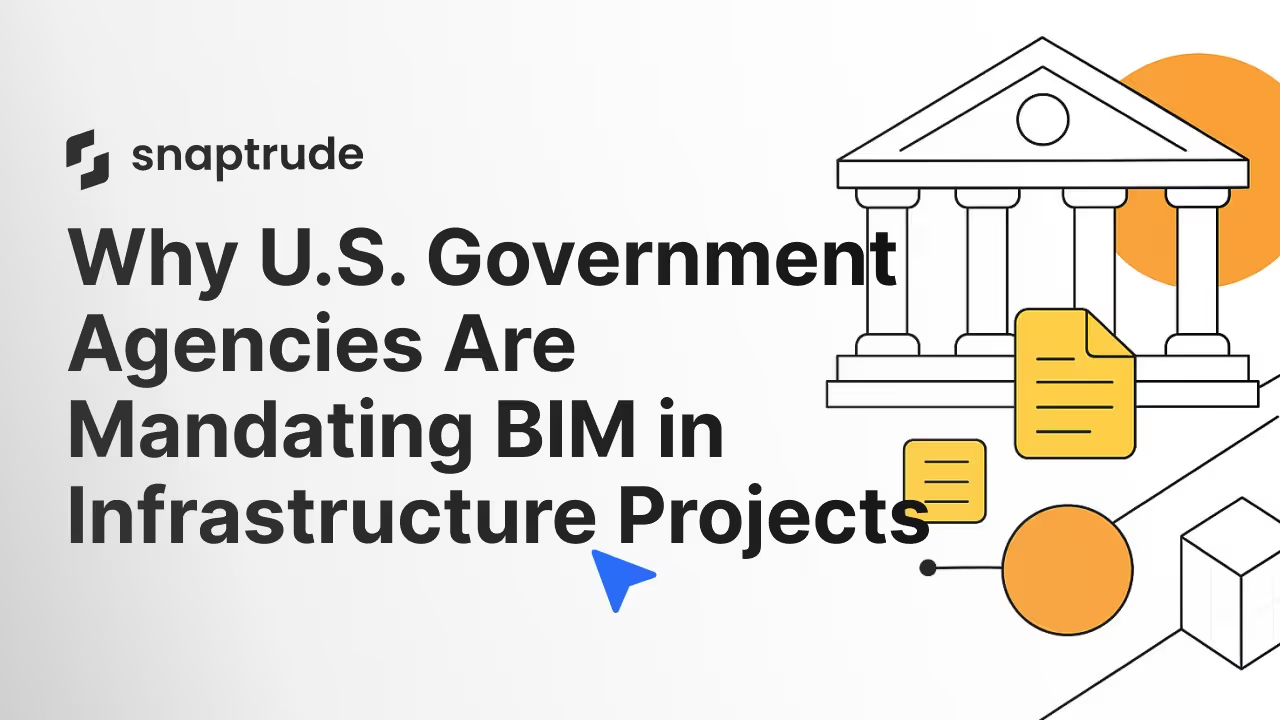Why U.S. Government Agencies Are Mandating BIM in Infrastructure Projects

In 2023, the U.S. Army Corps of Engineers announced a major infrastructure upgrade for the Martin Army Community Hospital. The project was massive—over 745,000 square feet, hundreds of contractors, and multiple phases over five years. But what made it truly modern wasn’t just the steel or the site—it was the software. The entire project was executed using BIM from day one.
And that wasn’t a one-off. Across federal, state, and municipal agencies, BIM (Building Information Modeling) is no longer a suggestion—it’s becoming the standard. From the General Services Administration (GSA) to the Department of Veterans Affairs and transportation departments across the country, agencies are adopting BIM mandates to improve project delivery, reduce waste, and future-proof public infrastructure.
So why BIM? And why now?
At its core, BIM is not just 3D modeling. It’s a way to embed data, relationships, and real-world behavior into a digital representation of a building or system. In BIM software like Snaptrude, Revit, or BIM 360, every wall, slab, and duct isn’t just geometry—it’s an object with material data, construction sequencing, energy performance, and cost implications.
For governments managing billions in infrastructure assets, that level of intelligence is gold.
First, there’s the issue of efficiency. Traditional CAD workflows are siloed and linear. You design in one tool, quantify in another, simulate in a third, and coordinate over email. BIM breaks that pattern. It brings all disciplines into a shared environment, where changes cascade automatically and conflicts are detected before they hit the site. For taxpayer-funded projects, that means fewer delays, fewer RFIs, and fewer change orders. The General Services Administration (GSA) estimates that BIM adoption has reduced rework in federal buildings by over 30%.
Then comes cost. BIM allows for detailed quantity take-offs, clash detection, and scheduling simulations (4D/5D modeling). That translates to better budget forecasting and fewer surprises during construction. The Martin Army project? Delivered on time and under budget. In an industry where 9 out of 10 megaprojects go over budget, that’s no small thing.
Compliance is another driver. Public sector projects face stricter codes, documentation standards, and reporting obligations. BIM streamlines this. Need to prove ADA compliance? Validate fire exit distances? Document lifecycle carbon for federal funding? A BIM model can output that data instantly. It's not just a model—it's an auditable record.
But mandates don’t happen in a vacuum. The push for BIM is tied to a broader transformation in how governments approach infrastructure. Climate adaptation, energy efficiency, and long-term asset management are all on the table. You can’t design for the next 50 years with tools built for the last 20. BIM, especially when paired with cloud-native platforms like Snaptrude, brings the visibility and flexibility needed for modern, resilient infrastructure.
Let’s not forget collaboration. Infrastructure isn’t designed in isolation. Architects, civil engineers, MEP consultants, environmental specialists, and owners all need to speak the same language. BIM gives them that shared vocabulary. And with tools like Snaptrude, that collaboration starts at the concept stage, not after the design is locked.
This matters especially for firms bidding on public contracts. As mandates increase, being BIM-ready isn’t optional—it’s a prerequisite. More agencies are issuing RFQs that require native BIM deliverables, IFC compliance, or coordination via platforms like BIM 360. Firms that cling to outdated workflows are quietly being filtered out.
And this isn’t just happening in the U.S. Countries like the U.K., Singapore, and the Nordic nations have already mandated BIM on most public works. The U.K., for example, has required Level 2 BIM for all centrally procured projects since 2016. Singapore has pushed for e-submissions via BIM since 2015, and India is exploring mandates through its Smart Cities Mission. While the U.S. has been slower to enforce a nationwide BIM mandate, the momentum is building. State governments like California, Texas, and New York are increasingly exploring BIM requirements for DOT (Department of Transportation) projects. The Federal Highway Administration (FHWA) is also funding pilot programs to digitize infrastructure delivery using BIM.
What sets Snaptrude apart in this space is how it brings early-stage design into the BIM conversation. Most BIM tools are built for documentation—they shine once the concept is finalized. Snaptrude flips that. It lets designers model site constraints, test massing options, simulate compliance, and generate reports—all before the first wall is drawn.
In one recent project, a U.S.-based architecture firm used Snaptrude to evaluate three different layouts for a civic complex. They tested Gross Floor Area (GFA), zoning compliance, parking ratios, and solar access—all in under two hours. By the time they transitioned to their documentation tool, 80% of the decisions were already validated.
This kind of front-loaded clarity is exactly what government agencies are looking for. It reduces design risk, improves accountability, and allows stakeholders to get aligned early. Whether you're bidding on a transit hub, a federal courthouse, or a wastewater treatment plant, Snaptrude gives your team the edge in both speed and accuracy.
Ultimately, the move toward BIM mandates reflects a larger shift: from drawings to data, from isolation to collaboration, and from reactive fixes to proactive planning. As infrastructure ages and climate pressures mount, governments need tools that offer transparency, coordination, and confidence.
BIM delivers that. And Snaptrude makes it accessible.
Looking to future-proof your firm for the next wave of public projects?
Start your BIM journey where it matters most—at the beginning.


